#Antonio Eligio Tonel
Text
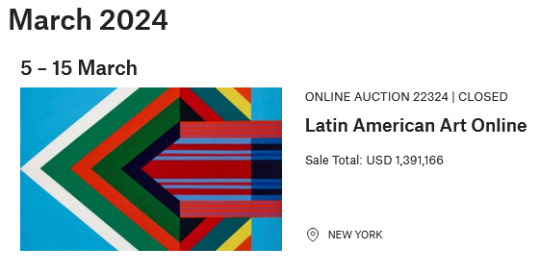
View On WordPress
#Antonio Eligio Tonel#Armando Mariño#Eduardo Hernández#Eduardo Ponjuán#Fernando Rodríguez#Flavio Garciandía#Gustavo Acosta#hablandodemercadodearte#José Ángel Toirac#José Bedia#Lázaro Saavedra#Los Carpinteros#Luís Martínez Pedro#Manuel Mendive#Pedro Álvarez#René Portocarrero#Roberto Diago#Rocío García#Tomás Esson#Tomás Sánchez#Wifredo Lam
0 notes
Text
Exposición “Como la caña”, Colectiva
Exposición “Como la caña”, Colectiva
Exposición Como la caña
Colectiva
05.02.2022
Factoría diseño
A lo largo de estos años, he visto como la interrelación entre las diferentes disciplinas, también llamado interdisciplinariedad, ha generado enriquecimientos recíprocos y satisfacciones varias. Ese engranaje de saberes y experiencias ahora ligados al campo del diseño y del arte, se citan en Factoría Diseño, nuevo espacio en el…

View On WordPress
#2022#Abel Barroso#Adrián Socorro#Antonio Eligio Tonel#Arien Chang#Factoría Diseño#Ibrahim Miranda#José Ángel Nazabal#José Ángel Toirac#José Ángel Vincenh#Muestra Colectiva#Nerea A. R. Vera#Raúl Cañibano#Rafael Villares#René "Pupy" Peña
0 notes
Text
Palabras de José Ángel Toirac
Palabras de José Ángel Toirac
Por Joaquín Borges-Triana
Una nueva edición de la Bienal de La Habana está en marcha y Miradas Desde Adentro no puede estar al margen de este suceso cultural. Por eso, reproducimos una entrevista realizada a José Ángel Toirac, a propósito de su participación en el aludido evento de las artes visuales.
José Ángel Toirac dentro de Lo posible
Por Andrés D. Abreu
José Ángel Toirac no se esperaba ser…
View On WordPress
#Alexander Arrechea#Antonio Eligio (Tonel)#Carlos Garaicoa#Dagoberto Rodríguez#Iván Capote#Marcos A. Castillo#Yoan Capote
0 notes
Text
Climate Change: Cuba/USA
January 12 – March 3, 2018 USF Contemporary Art Museum, Tampa Artists Glexis Novoa, Celia y Yunior, Antonio Eligio Fernández “Tonel” and Javier Castro will produce new works, in sculpture, painting, drawing, installation and video, that consider the changes, or “no changes,” that the political and diplomatic developments have wrought in their personal lives and in Cuban society. Glexis Novoa,…
View On WordPress
0 notes
Text
Inside the Biggest Show of Contemporary Cuban Art Ever

Raúl Corrales, La caballería [Calvary], 1960. © Estate Corrales. Courtesy of Couturier Gallery, Los Angeles.
Wifredo Lam, Ana Mendieta, Carmen Herrera, and Tania Bruguera: These names are among the small handful that American audiences may recognize when it comes to 20th-century Cuban art. But this familiar cohort tells a story only of Cuban art’s rich interaction with Western abstraction, and the country’s dissident and exiled voices. Now, a new survey of Cuban art at the Walker Art Center, “Adiós Utopia: Dreams and Deceptions in Cuban Art Since 1950,” is radically expanding that narrative.
Billing itself (accurately) as “the largest and most important exhibition of Cuban contemporary art ever organized,” the show offers a nuanced portrait of art made largely on the island, or by those who came of age within revolutionary Cuba, over the course of some 65 years. It finds its origin point in the decade preceding Fidel Castro’s takeover in 1959—shortly before relations between U.S. and Cuba deteriorated and the island grew increasingly isolated—and carries through to our present moment, amid renewed tensions between Cuba and the U.S. following a brief moment of change under President Obama’s administration.
The exhibition was conceived in 2013 by Ella Fontanals-Cisneros, founder and director of The Cisneros Fontanals Art Foundation (CIFO), in Miami, known for its groundbreaking collection of Latin American art. Cisneros, who is Cuban herself, recruited three curators with deep knowledge of the island’s art to steer this ambitious ship: Gerardo Mosquera, a prominent art critic and one of the founding members of the Bienal de La Habana, in 1984; Elsa Vega, former curator of Cuban art at the Museo Nacional de Bellas Artes in Havana; and René Francisco Rodríguez, a professor at Havana’s Instituto Superior de Arte.
The show has already completed a stint at the Museum of Fine Arts Houston (MFAH) earlier this year. (D.C.’s Hirshhorn Museum and Sculpture Garden and Miami’s Pérez Art Museum Miami ultimately turned down the exhibition, the latter amid fears that it would be too politically contentious in a city with a large population of Cuban expats.)

Glexis Novoa, Sin título, de la Etapa práctica [Untitled, from the Practical Stage], 1989. PAMM - Perez Art Museum, Miami. © Glexis Novoa. Courtesy of the Walker Art Center.
And while the exhibition avoids settling on any one political position, it burns hot. Indeed its opening room delivers something of a blow to the stomach. At the center of the gallery, two concrete blocks—one thinner slab placed beneath a hefty hunk with a curved edge—sandwich a series of human teeth, lined up in rows and embedded within the material. Depending on how you look at it, Yoan Capote’s Stress (in memoriam) (2004–12) could resemble a hulking, formless concrete mouth ready to consume whatever enters its purview, or a field of individuals—the teeth as stand-ins for humans—about to be crushed indiscriminately beneath the weight of a boulder.
Either way, one enters this exhibition with a feeling of pain, a sense of fragile humans lives caught in the crosshairs of momentous, inhumane forces. It’s a feeling that is only partly assuaged by two paintings that hang from adjacent walls, both offering utopian visions—though of different sorts, perhaps. In Eduardo Ponjuán González and René Francisco Rodríguez’s Productivismo (Productivism) (1992), a figure of a worker is poised as though to stoke coal in a glowing furnace, except his spade is replaced with a paintbrush: the artist as social realist hero. In the other, by Flavio Garciandía, a saccharin image shows a smiling girl lying on her back amid blades of grass, in a pastoral setting. But its title suggests this is no communist idyll. Called Ella está en otro día (She is in Another Day) (1975), it points to a fantasy realm.
The earliest works on view in the exhibition have roots in the 1950s, in the years before Fidel Castro’s seizure of power. The country’s more cosmopolitan, pre-Revolution condition can be seen in a selection of “concrete” paintings and sculptures, whose intersecting planes and logic relay another kind of utopianism—that of Western modernism and its cross-pollination with the aesthetics of Latin America during the mid-20th century. The balanced, harmonious compositions of Sandú Darié, Loló Soldevilla, Mario Carreño, and others speak in the universal language of abstraction, transcending the throes of human politics and divisions.

Raúl Martínez, 9 Repeticiones del Fidel con Micrófono [9 Repetitions of Fidel with a Microphone], 1968. © Archivo Raúl Martinez. Courtesy of the Walker Art Center.
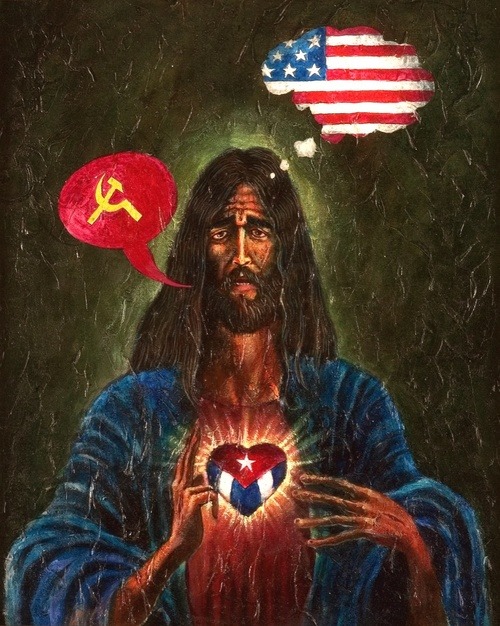
Lázaro Saavedra, El Sagrado Corazón [The Sacred Heart], 1995. © Lázaro Saavedra. Courtesy of the Walker Art Center.
What comes immediately after Castro’s coup, and into the ’60s and ’70s—a period that saw the radicalization of the new regime toward Marxist Socialism, as Antonio Eligio Fernández (Tonel) notes in the exhibition’s doorstep of a catalogue—are intensely romantic images of the revolution, as well as a contrary strain of increasingly satirical and critical art.
Raúl Corrales Fornos’s La Caballería (Cavalry) (1960), a triumphant, soaring image of mounted revolutionaries waving Cuban flags (a staged scene) is contrasted with an image like José A. Figueroa’s Olga (1967), which quietly illustrates the personal cost of Castro’s authoritarian regime. The photograph shows a woman far-off on an airport runway, seen through waving hands in the foreground—the artist bidding his mother goodbye as she left for the United States in 1967, shortly after Cuba established its alliance with the Soviet Union. (It would be 12 years before he saw her again.) It’s a picture tinged with the heartbreak of what so many in Cuba have suffered throughout the second half of the 20th century—what the catalogue calls “the massive exile and division of the Cuban family.”
Elsewhere in the exhibition, the most revelatory works offer a damning or deeply troubled perspective on the country through the deconstruction of its idols and symbols. Most of these come after Cuba’s so-called “Five-Year Gray Period” in the ’70s, when the government encouraged and sponsored art through state-run schools and issued aesthetic edicts—falling shy of imposing an official canon, as the Soviet bloc did. This critical strain of work accrued momentum during and after the emergence of the New Cuban Art of the 1980s, when artists who had grown up in the revolution became increasingly disenchanted with it.
(Later, following the collapse of the Soviet Union, which delivered a blow to Cuba’s already strained economy, government cultural policies once again tightened and many artists emigrated abroad, ultimately leading to the more international dialogue around Cuban art that exists today.)
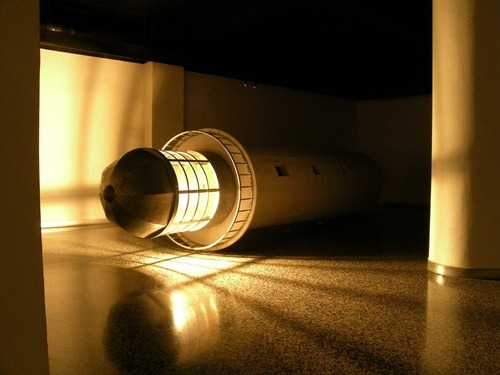
Los Carpinteros, Faro tumbado [Felled Lighthouse], 2006. American Fund for the Tate Gallery, Courtesy of the Latin American Acquisitions Committee 2006. © Los Carpinteros. Photo courtesy of the artists.
Tomás Esson’s My Homage to Che (1987) shows a muscular female body copulating with a pig-like beast in front of a painted rendition of Alberto Korda’s iconic image of Che Guevara as a heroic warrior. Lázaro Saavedra’s El Sagrado Corazón (The Sacred Heart) (1995) depicts an anxious Jesus with a furrowed, tortured brow. Far from being an icon of strength and hope, the savior is shown with a heart radiating the Cuban flag, but with a speech bubble containing the Soviet hammer and sickle, and a thought bubble filled with the stars and stripes of the United States. Bruguera’s Cuban flag is woven from human hair, a symbol eked out of human toil. And Wilfredo Prieto casts the flags of United Nations countries—including Cuba, Russia, and the U.S.—in greyscale, draining them of their vibrancy and revealing their common denominator: the graphic components that uphold systems of power.
José Ángel Toirac’s film Opus (2005), meanwhile, zeroes in on the endless statistics and numbers trotted out in Castro’s interminable speeches in order to showcase the achievements of the regime, here rendered empty and lifeless through repetition and abstraction. And Los Carpinteros’s giant, toppled lighthouse suggests the decline of a country that may once have offered a beacon or moral compass in a particularly fraught period of global history.
Cuba is, of course, an island—a condition that has enabled it to exercise self-imposed isolation. Toward the latter half of the exhibition, a searing gallery reminds us of this fact, poetically invoking the country’s watery surrounds. Manuel Piña’s epic, panoramic photograph shows a man jumping off Havana’s Malecón promenade following the collapse of the Soviet Union—seemingly leaping, liberated, into the abyss of the ocean. It’s an image that’s both euphoric in its sense of possibility and freedom, and tinged with melancholy. The untitled image was shot in 1992, three years after the destruction of the Berlin Wall.
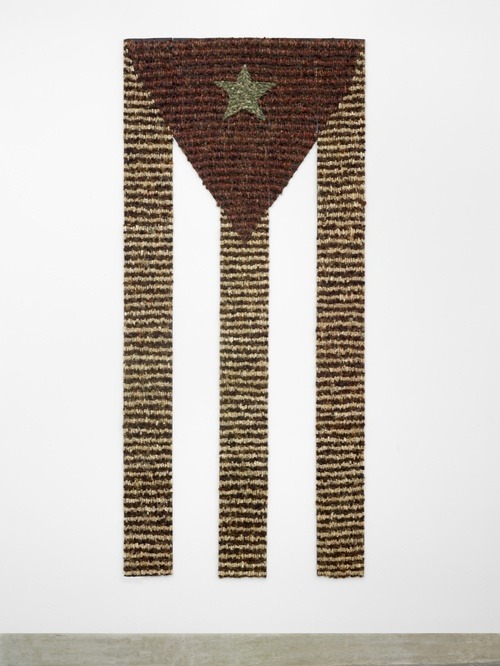
Tania Bruguera, Estadística [Statistics], 1995 – 2000. © Tania Bruguera. Courtesy of the Walker Art Center.
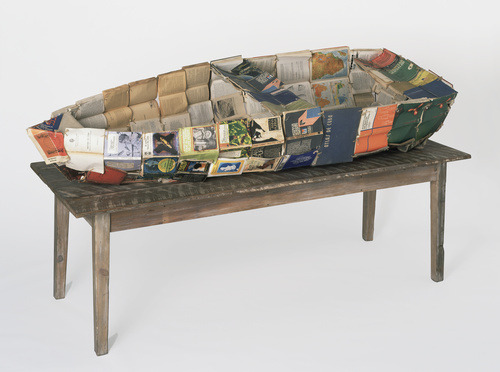
Kcho (Alexis Levya Machado), Obras escogidas [Selected works], 1994. Walker Art Center, Minneapolis. Courtesy of the Walker Art Center.
Another four years on, in 1996, the artist José Bedia made the hypnotic, soulful textile work Al límite posible (To the Possible Limit), which hangs across from Piña’s image, presenting another view of Havana’s Malecón. This time, it’s inward-looking: a half-moon-shaped wall-hanging that depicts the promenade face-on, with a constellation of lights radiating out in the water that abuts Havana’s coastline, and a figure far out at sea, tethered to the island by a life raft. Bedia, a practitioner of one of the country’s Afro-Cuban religions, Palo Monte, presents an image of a different kind of escape, a magical realist landscape—freedom through dreams.
Two standout works in the exhibition offer a less cathartic vision. Glenda León’s Longing (Añoranza) (2004) is small enough that you might miss it—a preserved butterfly perched on the wall, its wings glued together so that it’s unable to take flight. Close by is Iván Capote’s Dislexia (Dyslexia) (2003), a fragile kinetic sculpture created from repurposed machinery on the island. A mechanical arm moves back and forth across an oil-filled metal tray; like an overworked windshield wiper, it strains to keep the encroaching oil from obscuring a line of text engraved into the base of the tray: “La vida es un texto que aprendemos a leer demasiado tarde,” or “Life is a text that we learn to read too late.”
This poetic, bittersweet message appears momentarily before disappearing again beneath the viscous black substance. Like a mournful elegy, it cuts through the competing versions of utopia that lie beneath the story of art in Cuba, and conveys the particular struggle of artists to tell the truth despite many layers of political control and deception.

Raúl Martínez, Rosas y Estrellas [Roses and Stars], 1972. © Archivo Raúl Martinez. Courtesy of the Walker Art Center.
from Artsy News
0 notes
Text
Exposición “A mano y sin permiso”, Colectiva
Exposición “A mano y sin permiso”, Colectiva
Exposición “A mano y sin permiso”
Colectiva (colección privada)
10.11.2021
GALERIA HABANA
La evolución de artistas y espacios expositivos puede verse a través de esta muestra. Una vez más se refuerza ese criterio que he venido esgrimiendo desde hace un tiempo, la necesidad de fomentar el coleccionismo individual dentro de Cuba. “A mano y sin permiso” es el ejemplo más práctico que fundamenta…
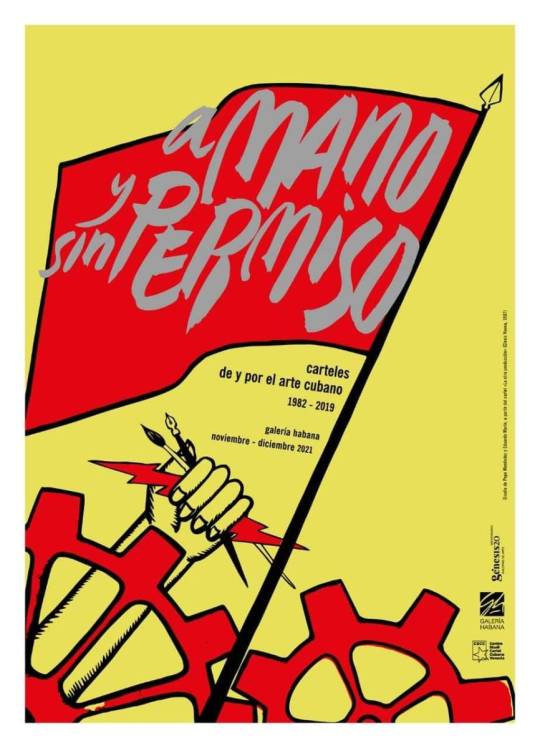
View On WordPress
#2021#Abel Barroso#Alberto Soria#Alexander Arrechea#Alexis Alejandro García#Alexis Somoza#Antonio Eligio Tonel#Anyelmaidelín Calzadilla#Arturo Cuenca#Álvaro Almaguer#Ángel Alonso#Ángel Barbachano#Ángel Ramírez#Ángel Rivero#Belkis Ayón#Carlos Cárdenas#Dagoberto Rodríguez#Duvier del Dago#Edel Bordón#Eduardo Abela#Eduardo Ponjuán#Eduardo Roca Salazar Choco#Eduardo Rubén García#Elio Rodríguez#Ernesto García Peña#Fabián Peña#Flavio Garciandía#Francisco Bernal#Galería Habana#Geysel Capetillo
0 notes
Text
Exposición “Acacia 1.2 Objetos de arte, variedades y fantasías”, Colectiva
Exposición “Acacia 1.2 Objetos de arte, variedades y fantasías”, Colectiva
Exposición Acacia 1.2 Objetos de arte, variedades y fantasías
Colectiva
20.10.2021
Galería Acacia
Tras un proceso de restauración, selección y curaduría de meses – pues las galerías no son solo esos momentos de inauguración y lobby que muchos disfrutan – la Galería Acacia presenta una exposición de fondos propios, que incluyen piezas de arte contemporáneo de la segunda mitad del siglo XX y…

View On WordPress
#2021#Adriano Buergo#Antonio Eligio Tonel#Armando Menocal#Arturo Cuenca#Ciro Quintana#Consuelo Castañeda#Eduardo Ponjuán#Galería Acacia#Gustavo Acosta#Gustavo Pérez Monzón#J. Ebeling#Jaime Valls#Jorge Rigol#José Emilio Fuentes (Jeff)#José Manuel Fors#Juan Gil García#Leopoldo Romañach#Linet Sánchez#Lisandra Ramírez#Manuel Mendive#Muestra Colectiva#Plastic Guajiras#René Portocarrero#Sandra Borges#Umberto Peña
0 notes
Text
Exposición "10 de 500 La Cuadratura del Círculo", Colectiva
Exposición “10 de 500 La Cuadratura del Círculo”, Colectiva
Exposición 10 de 500 La Cuadratura del Círculo
Colectiva
07.02.2020
Factoría Habana
“En 10 años de intensa presencia en el panorama de las artes visuales cubanas, el Centro de Arte Contemporáneo Factoría Habana se ha dado la labor de funcionar como medidor y propulsor de la producción nacional. Sobrepasando la cifra de treinta exhibiciones, ha presentado la obra de los actores más activos y…

View On WordPress
#2020#Adonis Ferro#Alejandro Campins#Antonio Eligio Tonel#Carlos Martiel#Cirenaica Moreira#Duvier del Dago#Ernesto Niebla#Ernesto Oroza#Esterio Segura#Fabián Múñoz#Fernando Rodríguez#Galería Factoría Habana#Humberto Diaz#José Ángel Toirac#José M. Mesías#Luis Gomez#Muestra Colectiva#Octavio C. Marín#Rafael Villares#René Peña#Rocío García#Sandra Ramos
0 notes
Text
Exposición "Intersecciones", Colectiva
Exposición colectiva en #FactoríaHabana síguenos en nuestras redes sociales
Exposición “Intersecciones”
XIII Bienal de la Habana
12.04.2019
Factoría Habana
La galería Factoría Habana abre sus puertas para la exposición colectiva Intersecciones, la cual trascenderá el marco de la XIII Bienal de La Habana. En ella se dan cita, bajo la curaduría de Concha Fontela, los artistas Alexander Arrechea, Iván y Yoan Capote, Marco A. Castillo, Antonio E. Fernández (Tonel),…

View On WordPress
#2019#Alexander Arrechea#Amor Múñoz#Andrés Klimek#Antonio Eligio Tonel#Carlos Garaicoa#Clara Porset#Dagoberto Rodríguez#Fernando Rodríguez#Galería Factoría Habana#Gónzalo Córdoba#Gustavo Pérez Monzón#Iván Capote#José Ángel Toirac#Lucila Aguilar#Luis Ramírez#Marcos A. Castillo#Muestra Colectiva#Rafael Villares#Sergio Donis#XIII Bienal de la Habana#Yoan Capote
0 notes